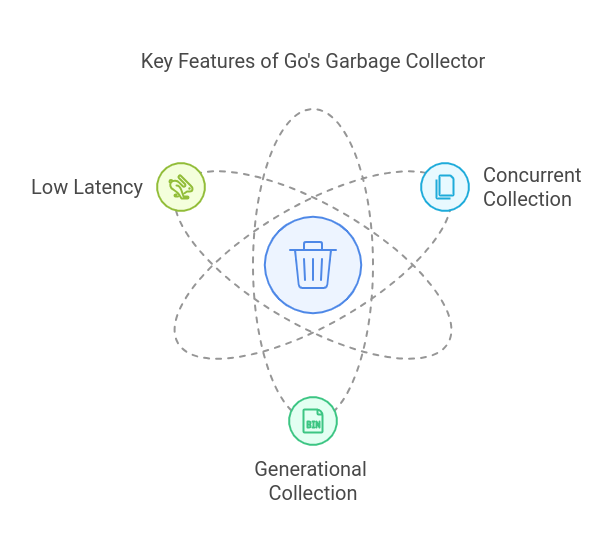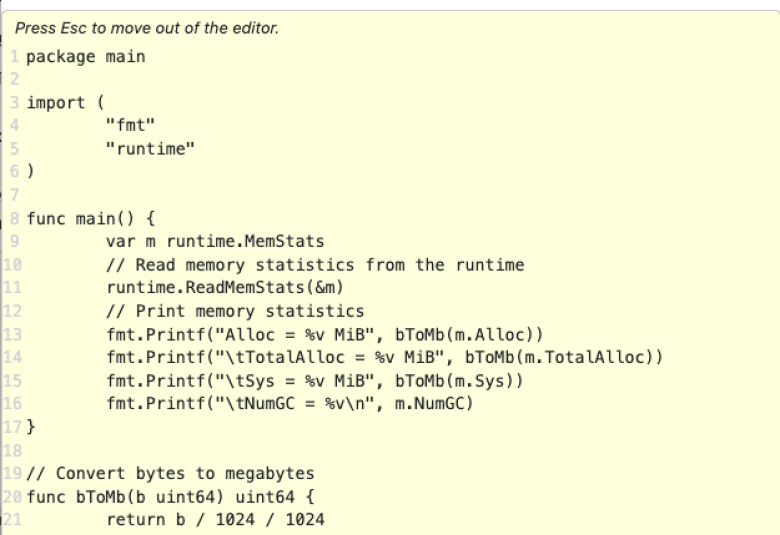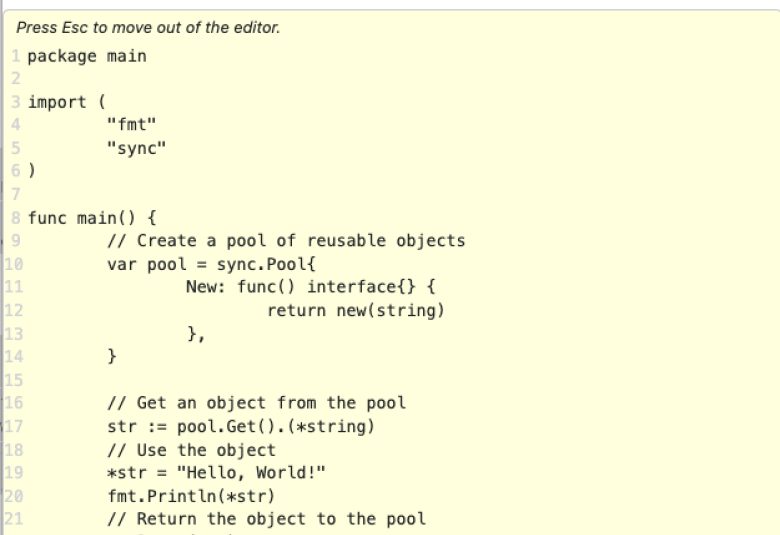Go, often praised for its simplicity and speed, has a powerful memory management system. This article explores the main parts of Go’s memory management, including the garbage collector, memory allocation, profiling, and techniques to optimize memory usage.
Understanding Go’s Garbage Collector
In simple terms, Go's garbage collector (GC) is like a behind-the-scenes helper that manages the program's memory for you. Its main job is to clean up memory that your program no longer uses, ensuring that your application doesn't run out of memory or suffer from memory leaks (when unused memory isn’t released).
How Does It Work?
Go's garbage collector uses a technique called concurrent mark-and-sweep, which is designed to work efficiently without interrupting your program’s performance:
- Mark Phase:
The garbage collector first identifies which parts of your program's memory are still being used (these are called "reachable" objects). - Sweep Phase:
Once it knows what is still in use, the GC clears out (or "sweeps away") the memory that is no longer needed, freeing it up for future use.
Why Is It Called Concurrent?
The term concurrent means that the garbage collector runs alongside your program instead of stopping it entirely. This is important because some garbage collectors in other languages pause the entire program while cleaning up memory, causing delays. In Go, the GC works in the background, minimizing pauses and making sure your program runs smoothly.
Key Benefits of Go's Garbage Collector:
- Automatic Memory Management: Developers don’t need to manually allocate or free memory, which reduces bugs and simplifies code.
- Low Latency: It’s designed to be fast and doesn’t make your program freeze, even when it’s actively cleaning up.
Optimized for Performance: It focuses on freeing short-lived objects quickly, which is common in modern applications. - In essence, Go's garbage collector ensures your application efficiently uses memory without requiring extra effort from you, leaving you free to focus on building great software.
Key Features of Go’s Garbage Collector:
- Concurrent Collection: The garbage collector works at the same time as your program, reducing the times when your program has to pause.
- Generational Collection: The garbage collector looks at how long objects have been around, making it quicker to clean up short-lived objects.
- Low Latency: The garbage collector is designed to work quickly, keeping your program running smoothly.

Example: Managing Memory with GC
package main
import (
"fmt"
"runtime"
)
func main() {
var m runtime.MemStats
// Read memory statistics from the runtime
runtime.ReadMemStats(&m)
// Print memory statistics
fmt.Printf("Alloc = %v MiB", bToMb(m.Alloc))
fmt.Printf("\tTotalAlloc = %v MiB", bToMb(m.TotalAlloc))
fmt.Printf("\tSys = %v MiB", bToMb(m.Sys))
fmt.Printf("\tNumGC = %v\n", m.NumGC)
}
// Convert bytes to megabytes
func bToMb(b uint64) uint64 {
return b / 1024 / 1024
}
This code shows how to get and print memory statistics from Go's runtime. The runtime.ReadMemStats function fills in a runtime.MemStats structure with lots of useful information about memory usage.
Memory Allocation and Profiling
When writing efficient Go programs, understanding how memory is allocated can greatly enhance your application's performance. Go primarily uses two types of memory for storing variables: stack and heap. Each serves a specific purpose, and Go's memory management system decides where variables should be placed.
The Stack
The stack is a fast and small memory area used to store short-lived variables that have a well-defined lifetime. When a function is called, the memory for its local variables is allocated on the stack. Once the function finishes, this memory is automatically deallocated (freed).Advantages:
- Fast allocation and deallocation.
- Minimal impact on garbage collection since memory is automatically freed when the function exits.
The Heap
The heap is a larger memory area used to store variables with an unknown or longer lifetime, such as variables that need to persist beyond the scope of the function that created them. Go’s garbage collector is responsible for cleaning up memory on the heap once it’s no longer needed.Advantages:
- Suitable for dynamic memory needs or variables shared between goroutines.
Disadvantages
- Slower allocation and deallocation compared to the stack.
- Involves more work for the garbage collector, which can impact performance.
Profiling Memory Usage:
Go has tools like pprof to help you analyze memory usage. These tools can help you find memory leaks and optimize your program's memory usage.
Example: Profiling Memory
package main
import (
"log"
"net/http"
_ "net/http/pprof" // Import the pprof package for profiling
)
func main() {
// Start an HTTP server for pprof on localhost:6060
go func() {
log.Println(http.ListenAndServe("localhost:6060", nil))
}()
// Simulate workload
for i := 0; i < 10; i++ {
go func() {
for {
_ = make([]byte, 1024*1024)
}
}()
}
}
This code starts a pprof server on localhost:6060. You can use a web browser to visit http://localhost:6060/debug/pprof/ and see detailed information about your program's memory usage.
Optimizing Memory Usage in Go Applications
Optimizing memory usage can make your Go programs run faster and use less memory. Here are some tips:
- Avoid Global Variables: Use local variables whenever you can to reduce the amount of memory that is allocated on the heap.
- Use Sync.Pool: Reuse objects instead of creating new ones all the time. This reduces the workload on the garbage collector.
- Profile Regularly: Use profiling tools to regularly check for memory leaks and optimize your program's memory usage.

Example: Using Sync.Pool
package main
import (
"fmt"
"sync"
)
func main() {
// Create a pool of reusable objects
var pool = sync.Pool{
New: func() interface{} {
return new(string)
},
}
// Get an object from the pool
str := pool.Get().(*string)
// Use the object
*str = "Hello, World!"
fmt.Println(*str)
// Return the object to the pool
pool.Put(str)
}
Using sync.Pool can significantly reduce the pressure on the garbage collector by reusing objects instead of creating new ones.
Conclusion
Understanding and optimizing memory management in Go is important for developing high-performance programs. By using Go's garbage collector effectively, understanding memory allocation, and regularly profiling and optimizing your code, you can make sure your Go programs run smoothly and efficiently.








